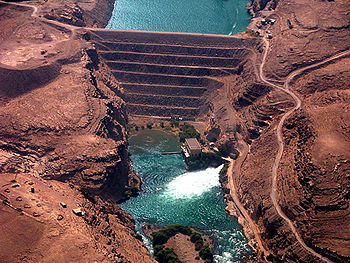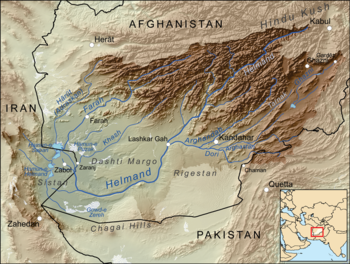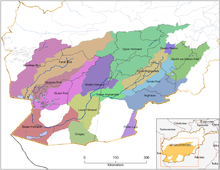- Helmand River
-
"Hirmand" redirects here. For the administrative subdivision of Iran, see Hirmand County.
Helmand River Length 1,150 km The Helmand River (also spelled Helmend, Helmund, Hirmand; Pashto/Persian: هیرمند, هلمند Hīrmand, Helmand, Latin: Erymandrus) is the longest river in Afghanistan and the primarily watershed for the endorheic Sistan Basin.[1]
The river gives its name to Helmand Province. Haetumant (Avestan and Old Persian "dam-full", cognate with Indic Setumanta "having dam") was an early name for the Helmand River and the irrigated areas around it.[2]
The Helmand river stretches for 1,150 km (710 mi). It rises in the Hindu Kush mountains, about 80 km (50 mi) west of Kabul (34°34′N 68°33′E / 34.567°N 68.55°E), passing north of the Unai Pass. It crosses south-west through the desert of Dashti Margo, to the Seistan marshes and the Hamun-i-Helmand lake region around Zabol at the Afghan-Iranian border (31°9′N 61°33′E / 31.15°N 61.55°E).
The river remains relatively salt-free for much of its length, unlike most rivers with no outlet to the sea. This river is used extensively for irrigation, although a buildup of mineral salts has decreased its usefulness in watering crops. Its waters are essential for farmers in Afghanistan, but it feeds into Lake Hamun and is also important to farmers in Iran's southeastern Sistan and Baluchistan province.
A number of hydroelectric dams have created artificial reservoirs on some of the Afghanistan’s rivers including the Kajakai reservoir on the Helmand River. The chief tributary of the Helmand river is the Arghandab river (confluence at 31°27′N 64°23′E / 31.45°N 64.383°E) which also has a major dam near the city of Kandahar.
The boundaries of Helmand has been known as kingdom of Sakastan.
Contents
Helmand River Valley
Is the valley formed by the Helmand River. It is the area along the river with the largest number of human settlements due to its proximity to the river.
See also
 The Kajaki Dam provides flood control, power and irrigation water to the Helmand Valley. Without the dam, the surrounding region would be arid and would not be able to produce crops.
The Kajaki Dam provides flood control, power and irrigation water to the Helmand Valley. Without the dam, the surrounding region would be arid and would not be able to produce crops.
Notes
- ^ "History of Environmental Change in the Sistan Basin 1976 - 2005". http://postconflict.unep.ch/publications/sistan.pdf. Retrieved 2007-07-20.
- ^ Jack Finegan. Myth & mystery: an introduction to the pagan religions of the biblical world. Baker Books, 1997. ISBN 080102160X, 9780801021602
References
- Various authors. "HELMAND RIVER". Encyclopædia Iranica (Online Edition ed.). United States: Columbia University. http://www.iranica.com/newsite/articles/unicode/v12f2/v12f2026.html.
- Frye, Richard N. (1963). The Heritage of Persia. World Publishing company, Cleveland, Ohio. Mentor Book edition, 1966.
- Toynbee, Arnold J. (1961). Between Oxus and Jumna. London. Oxford University Press.
- Vogelsang, W. (1985). "Early historical Arachosia in South-east Afghanistan; Meeting-place between East and West." Iranica antiqua, 20 (1985), pp. 55-99.
External links
Categories:- Helmand River
- Rivers of Afghanistan
- Helmand River drainage basin
- Rivers of Iran
- International rivers of Asia
Wikimedia Foundation. 2010.


